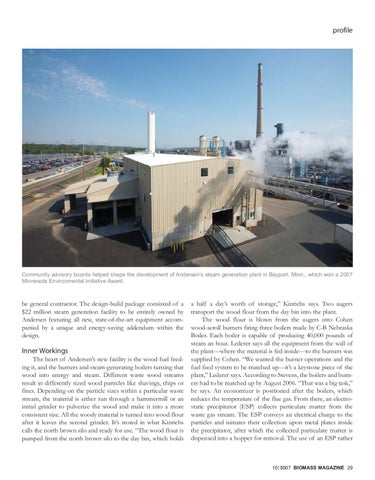profile
Community advisory boards helped shape the development of Andersen’s steam generation plant in Bayport, Minn., which won a 2007 Minnesota Environmental Initiative Award.
be general contractor. The design-build package consisted of a $22 million steam generation facility to be entirely owned by Andersen featuring all new, state-of-the-art equipment accompanied by a unique and energy-saving addendum within the design.
Inner Workings The heart of Andersen’s new facility is the wood fuel feeding it, and the burners and steam-generating boilers turning that wood into energy and steam. Different waste wood streams result in differently sized wood particles like shavings, chips or fines. Depending on the particle sizes within a particular waste stream, the material is either run through a hammermill or an initial grinder to pulverize the wood and make it into a more consistent size. All the woody material is turned into wood flour after it leaves the second grinder. It’s stored in what Kinrichs calls the north brown silo and ready for use. “The wood flour is pumped from the north brown silo to the day bin, which holds
a half a day’s worth of storage,” Kinrichs says. Two augers transport the wood flour from the day bin into the plant. The wood flour is blown from the augers into Cohen wood-scroll burners firing three boilers made by C-B Nebraska Boiler. Each boiler is capable of producing 40,000 pounds of steam an hour. Lederer says all the equipment from the wall of the plant—where the material is fed inside—to the burners was supplied by Cohen. “We wanted the burner operations and the fuel feed system to be matched up—it’s a keystone piece of the plant,” Lederer says. According to Stevens, the boilers and burners had to be matched up by August 2006. “That was a big task,” he says. An economizer is positioned after the boilers, which reduces the temperature of the flue gas. From there, an electrostatic precipitator (ESP) collects particulate matter from the waste gas stream. The ESP conveys an electrical charge to the particles and initiates their collection upon metal plates inside the precipitator, after which the collected particulate matter is dispensed into a hopper for removal. The use of an ESP rather
10|2007 BIOMASS MAGAZINE 29
